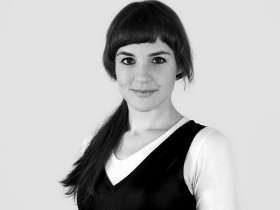Kopfstand 09: Sehen, wie die Stadt klingt

Anna-Lena Kornfeld
How can the sounds of a city be mapped and represented graphically? On September 1, the latest installment of the Kopfstand09 series dealt with this very question.
Local Description of a Non-Place
According to Linz09 Musical Director Peter Androsch, the cartographic visualization of an audible urban environment is demanding due to its complexity—it’s a local description of a non-place. So it comes as no surprise that, up to now, there’s been no plausible scientific method to visualize urban soundscapes. Recordings are merely sound registers that constitute a crude representation of traffic frequency. Anna-Lena Kornfeld, a geographer living in Hamburg, has now become the first scholar to approach this phenomenon scientifically, and she seems to have come up with a convincing solution. On September 1, Anna-Lena Kornfeld presented her results at a Kopfstand get-together.
Masters Thesis Field Research in Downtown Hamburg
In conjunction with work on her masters thesis entitled “Soundslike,” Anna-Lena Kornfeld recorded and cartographically visualized the soundscape of Schanzenviertel, a lively Hamburg inner city neighborhood. What’s special about this is the fact that the geographer didn’t limit her efforts to charting decibel levels as is the case with most conventional “noise level measurement procedures”; she also registered the frequency of the various sound sources. She then performed quantitative and qualitative evaluations and depicted this information in a so-called sound mapping. This procedure also makes it possible to see the dynamics of the individual sounds (street, elevated railway, pedestrians, restaurants/cafés/bars) at various times of day. In going about her work, Anna-Lena Kornfeld investigated and combined a wide variety of visualization methods including 3D animation, notation system and isophone. “Classical cartography wasn’t even nearly adequate to this task,” said Anna-Lena Kornfeld, who’s been working on an interdisciplinary research project at the HafenCity University Hamburg since Spring 2008.
Significance of the Visualization of Acoustics
The young scholar is well aware of the fact that she’s doing pioneering research. Also that her work has not exactly triggered a storm of enthusiasm among local government agencies. “What I want to do with this project is to create a data base that can serve as the foundation for development in the future, when the aim is to design cities that are more harmonious and inhabitant-friendlier as far as the acoustics are concerned. But awareness of these considerations on the part of bureaucrats is not yet very pronounced,” according to Anna-Lena Kornfeld.
Additional information about Soundslike—including several soundmaps—is available online at www.acoustic-geography.com.





